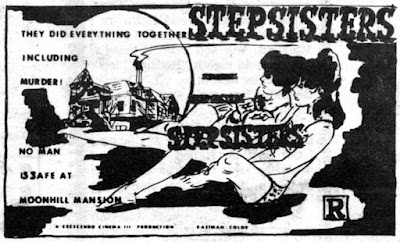THE PRESIDENT MUST DIE (1981)
Directed by
James L. Conway
Produced by
Charles E. Sellier, Jr.
Written by
James L. Conway
and
Cliff Osmond
Photography
by
Paul Hipp
Edited by
Trevor Jolly
Music by
Don Perry
Assistant Director
Leon Dudevoir
Costumes
Julie Staheli
Design
Paul Staheli
Chip Radaelli
A
Sunn Classic Pictures
production
Released by
Jensen Farley Pictures
MPAA rating: G
***
Excerpts from
“Making Movies the Computer Way”
by Patricia Morrisroe
Parade magazine
(February 2-3, 1980, p.16)
Welcome to the age of computerized entertainment, where movies are conceived, created and marketed like boxes of breakfast cereal. The idea was not the brainchild of IBM, however, but of a Mormon organization in Park City, Utah, called Sunn Classic Pictures.
Since 1974, thanks to its new testing system, Sunn has produced an unbroken chain of “hits” – 17 movies that have each grossed an average of $14 million. Its most successful picture, IN SEARCH OF NOAH’S ARK, made for only $360,000, has returned $28 million at the box-office. By using cost-cutting devices, such as small casts of little-known actors and non-union crews, Sunn can spend huge amounts on expensive but well-timed television advertisements. As a result, audiences flock to see their “limited run” movies. In a business where six out of seven films lose money, Sunn’s pictures regularly gross 30 times their production costs, a ration enjoyed by only a handful of films in history.
The inspiration behind Sunn’s approach is its president, Charles E. Sellier Jr., 36, a Mormon convert who attributes his good fortune to two important factors: God and the computer.
In 1971, Sellier was hired by American National Enterprises, the originators of a scheme known as “four-walling,” whereby a movie company rents selected theaters for a flat fee and gets all the box-office dollars instead of giving theaters a percentage of the gross in exchange for paying their own overhead. This technique, combined with hefty amounts of TV advertisements, benefits smaller film companies like Sunn which otherwise might never get their movies shown. “Because we pay for the use of the theater,” Sellier says, “we have to make sure our product is completely attuned to the audience. If nobody comes, we lose a lot of money.”
Sellier’s first major step in assuring the profitability of his pictures was selecting his audience and determining their tastes. Through a computerized test-marketing system, Sellier identified his main target group: working-class families who attend films only once or twice a year. In pinpointing this market, Sellier had found an unexplored resource. “Only 23 percent of the U.S. population sees movies with any sort of regularity,” he says. “Hollywood is just not making the kind of films that turn on the other 77 percent. All we did was find an angle that other people weren’t pursuing.”
Under Sellier’s system, the audience practically designs every aspect of the film themselves. Each month researchers are dispatched across the country to question potential moviegoers on unusual ideas, newspaper articles, current books, or anything else that might get them out of the house and into the theater.
Once the most popular ideas are collated, Sunn’s research teams are sent out again. This time the man-on-street is asked to help flesh out the concepts. Take, for example, the research conducted for THE PRESIDENT MUST DIE, a docu-drama on the assassination of John F. Kennedy.
“After feeding our data into the computer,” explains screenwriter Brian Russell, “we went with the conspiracy theory – the premise that was closest to what the majority believed.” What if the computer had pinned the blame solely on Oswald? “We would have gone with that angle instead,” Russell says. “We’re interested in drama, not politics.”









































